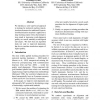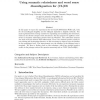121 search results - page 4 / 25 » Word Sense Disambiguation Improves Statistical Machine Trans... |
ACL
2006
13 years 11 months ago
2006
We introduce a semi-supervised approach to training for statistical machine translation that alternates the traditional Expectation Maximization step that is applied on a large tr...
CLEF
2009
Springer
13 years 11 months ago
2009
Springer
In this paper we report the experiments for the CLEF 2009 Robust-WSD task, both for the monolingual (English) and the bilingual (Spanish to English) subtasks. Our main experimenta...
TAL
2004
Springer
14 years 3 months ago
2004
Springer
This paper presents an algorithm to apply the smoothing techniques described in [1] to three different Machine Learning (ML) methods for Word Sense Disambiguation (WSD). The method...
BMCBI
2010
13 years 10 months ago
2010
Background: Word sense disambiguation (WSD) algorithms attempt to select the proper sense of ambiguous terms in text. Resources like the UMLS provide a reference thesaurus to be u...
TREC
2000
13 years 11 months ago
2000
We investigated the dictionary-based query translation method combining the translation disambiguation process using statistic cooccurrence information trained from the provided c...


